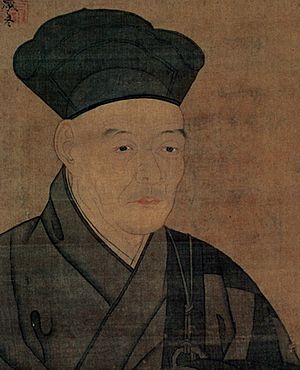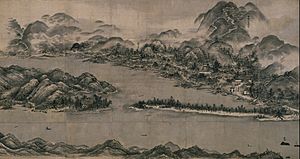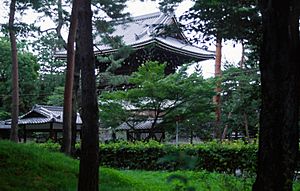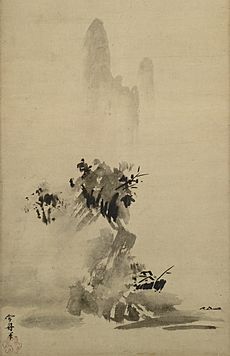Sesshū Tōyō facts for kids
Quick facts for kids Sesshū Tōyō |
|
|---|---|

A 16th-century copy of Sesshū's 1491 self-portrait
|
|
| Religion | Buddhism |
| School | Rinzai |
| Personal | |
| Born | 1420 Bitchū, Japan |
| Died | 26 August 1506 |
| Senior posting | |
| Title |
|
| Religious career | |
| Teacher | Tenshō Shūbun |
Sesshū Tōyō (Japanese: 雪舟 等楊) was a super famous Japanese artist. He lived a long time ago, from 1420 to 1506. Sesshū was known as the greatest master of ink and wash painting during the middle Muromachi period in Japan.
He was born into a samurai family, but he became a Zen Buddhist priest. Even when he was young, Sesshū showed a great talent for art. He grew up to be one of the most important artists in Japan and even in China.
Sesshū learned from a teacher named Tenshō Shūbun. He was also inspired by Chinese landscape paintings from the Song Dynasty. Later, he traveled to China himself. There, people quickly saw how amazing his paintings were.
When Sesshū came back to Japan, he opened his own art studio. Many painters learned from him. This group of artists is now called the Unkoku-rin school, or "School of Sesshū." We still have many paintings with his name or seal. However, only a few are definitely known to be painted by him. His most famous artwork is a very long scroll called the "Long Landscape Scroll."
Contents
Sesshū Tōyō's Life Story
Sesshū was born in a place called Akahama, in what is now western Okayama Prefecture. His family name was Oda. We don't know his first name. He got the name Tōyō in 1431. This was when he joined Hōfuku-ji, a Zen temple in Sōja.
Around 1440, Sesshū moved to Kyoto, which was the capital city of Japan back then. He lived as a monk at Shōkoku-ji, a famous Zen temple. There, he studied Zen with a famous master named Shunrin Suto. He also learned painting from Tenshō Shūbun. Shūbun was the most respected Japanese painter of that time.
Shūbun's painting style, like many Japanese Zen painters, was inspired by Chinese artists. These included painters from the Song Dynasty like Ma Yuan and Xia Gui. Sesshū spent about 20 years in Kyoto. Then, he moved to Yamaguchi Prefecture to become the head priest of Unkoku temple. Around this time, he started calling himself Sesshū, which means "snow boat."
Yamaguchi was a place where many Japanese trips to China began. Maybe Sesshū chose to live there because he wanted to visit China. He got an invitation from the Ōuchi clan, who were powerful lords in Japan. He joined a trading trip and arrived in Southern China in 1468.
His job was to buy Chinese artworks for rich Japanese people. He also visited and studied at Chinese Zen temples. Sesshū was a bit disappointed with the art of the Ming dynasty. He felt it was very different from the older Song styles he admired. However, he loved Chinese nature and temples.
He quickly became known as an important painter in China. One old record says he might have even gotten a request from the Imperial Palace in Beijing. We don't know if this is true or if he accepted. The best paintings we have from his time in China are four landscape scrolls. They are now kept at the Tokyo National Museum.
Sesshū stayed in China until 1469. When he returned, he couldn't go back to Yamaguchi because of a war called the Ōnin War. So, he settled in Ōita Prefecture in Kyūshū. There, he built his own studio called Tenkai Zuga-rō.
He spent his time painting and teaching. He also often traveled to different parts of Japan. On one trip in 1478, Sesshū visited Masuda, Shimane. He was invited by Kanetaka Masuda, the lord of Iwami Province. While there, Sesshū created two Zen gardens and painted a portrait of Masuda Kanetaka. He also painted a work called The Birds and Flowers of Four Seasons.
In 1486, Sesshū returned to Yamaguchi. Many of his most famous works are from the last years of his life. These include the Long Landscape Scroll (1486) and the Splashed-ink Landscape (1495). Another famous work is View of Ama-no-Hashidate (around 1501–05). This painting shows a famous sandbar in Tango Province from high above. To paint it, Sesshū, who was already in his eighties, had to climb a tall mountain. This shows he was still very healthy!
Sesshū Tōyō passed away in 1506, when he was 87 years old. We know what he looked like from a copy of a self-portrait made by one of his students.
Sesshū's Amazing Artworks

Many paintings from Sesshū's time have his signature or seal. However, only a few are definitely known to be painted by him. Many are copies or works by his students. Some painters, like Hasegawa Tōhaku, even used Sesshū's name because they admired him so much. Artists who were greatly influenced by Sesshū's style are part of the "School of Sesshū."
Perhaps the most important painting by Sesshū is the Long Scroll of Landscapes. This scroll is about 50 feet (15 meters) long! It shows the four seasons: spring, summer, autumn, and winter, all in one continuous scene.
There are two other large landscape scrolls that are thought to be by Sesshū. The smaller "Four Seasons" scroll, also called the Short Scroll of Landscapes, is similar to the Long Scroll. It uses a slightly freer painting style. The View of Ama-no-Hashidate, painted shortly before he died, is very special. It's different from traditional Chinese art because it shows a realistic view of a specific place, as if you were looking down from a bird's eye view.
Other famous works by Sesshū include a Buddhist painting called Huike Offering His Arm to Bodhidharma. This painting was made in 1496 and is now considered a National Treasure of Japan. He also painted a pair of beautiful screens with pictures of flowers and birds.
Famous Landscape Paintings by Sesshū
- Landscape of the Four Seasons, four scrolls (before 1469; Tokyo National Museum)
- Landscapes of Autumn and Winter, two hanging scrolls (c. 1470–90; Tokyo National Museum)
- Short Scroll of Landscapes (c. 1474–90; Kyoto National Museum)
- Long Scroll of Landscapes (Sansui Chokan) (c. 1486; Mori Collection, Yamaguchi, Japan)
- Haboku Sansui, a "splashed-ink" scroll (1495; Tokyo National Museum)
- View of Ama-no-Hashidate (c. 1502–05; Kyoto National Museum)
- Landscape by Sesshū
Images for kids
See also
 In Spanish: Sesshū Tōyō para niños
In Spanish: Sesshū Tōyō para niños





